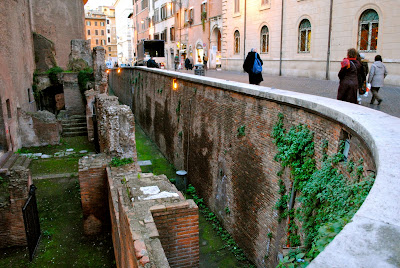The concept of layering has been around for centuries, and it is something which we often overlook. We see this concept being used everyday, but it often goes unnoticed. Although we have been viewing this concept throughout this entire trip, week 3 really emphasized it. We began by viewing it in Campus Martius. We saw where the Theatre of Pompey once stood, and how the existing buildings are built on top of it. The strong concrete remains are used as foundations which allow taller and larger buildings to be created. We then looked at the Pantheon, and could see evidence of its previous layers. The Pantheon we see today, done under the ruling of Hadrian, was the third to be built. Probably the clearest example of layering, we can see is towards the back, where we can clearly see how Rome has been constructed layer by layer to eventually rise over the original ground level where the Pantheon once stood.
 |
| Roman Columns |
 |
| Example of inglobale |
 |
| Original vs. Existing Ground Level of the Pantheon |
 |
| Mausoleum of Augustus |
 |
| Documentation of Flood Levels |
In our studio class, we utilized our drafting techniques by combining many layers to create one drawing. We used layering in the design of our layouts, toning, and composition.
In our field studies course, we visited the Ara Pacis Museum built by Richard Meier. The museum houses the Altar of Peace which was reconstructed by placing both new and old pieces together. We analyzed the museum and created a composition by overlapping the drawings in axon, detail, and plan.
Everyday we face and often overlook this concept. It is important to note how the layering of different elements has played such a crucial point in our history and how it will continue to shape our future.
 |
| Ara Pacis Museum |
|
Model of the Altar of Peace |
|
| Sketching exercise of Ara Pacis Museum |
 |
| Altar of Peace |
By Patrick Davidson and Jamie Dalgleish













No comments:
Post a Comment